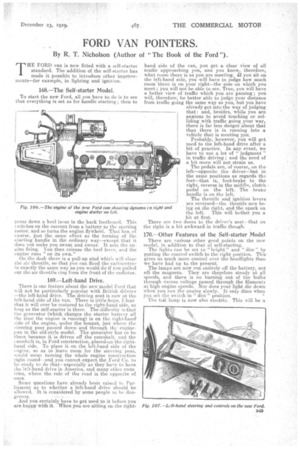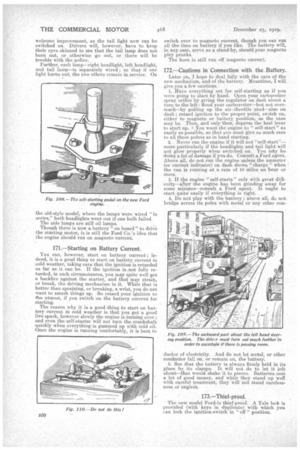FORD VAN POINTERS.
Page 23

Page 24

If you've noticed an error in this article please click here to report it so we can fix it.
By R. T. Nicholson (Author of "The Book of the Ford ").
THE FORD van is now fitted with a self-starter standard. The addition of the self-starter has made it Possible to introduce other imprbvements—for example, in lighting and ignition.
168.—The Self-starter Model.
To start the new Ford, all you have to do is to see that everything is set as for handle starting ; then to press down a heel lever in the back footboard. This switches on the current from a battery to the starting motor, and so turns the engine flywheel. That has, of course, just the same effect as the turning of the starting handle in the ordinary way—except that it does not make you sweat and swear. It sets the engine firing. You then release the heel lever, and the engine runs " on its own."
On the dash there is a pull-up stud which will close ihe air throttle, so that you can flood the carburetter in exactly the same way as you would do if you pulled out the air throttle ring from the front of the radiator.
169.—Left-hand Drive.
There is one feature about the new Model Ford that will not be particularly popular with British drivers --the left-hand drive. The driving seat is now at the left-hand side of the van. There is little,hope, I fear that it will ever he restored to the right-hand side, so long as the self-starter is there. The difficulty is that. the generator (which charges the starter battery all the time the engine is running) is on the right-hand' side of the engine, under the bonnet, just where the steering post passed down and through the enginepan in the old-style model. The generator has to be there because it is driven off the camshaft, and the 4.itanshaft is, in Ford construction, placed-on the righthand side. To place it on the left-hand side of the engine, so as to leave room for the steering post, would mean turning the -whole engine construction right round---and you cannot expect the Ford Co. to be ready to do that--especially as they have to have the left-hand drive in America, and many other countries, where the rule of the. road is the opposite of ours.
Some questions have already been raised me Parliament. as to whether a left-hand drive should be allowed. it is considered by some people to be dangerous.
And you certainly have to get used to it before you are happy with it. When you are sitting. on the right•
hand side of the van, you get a clear view of all traffic approaching you, and you know, therefore, what room there is as you are meeting. af you sit on the left-hand side, you will have to judge how much room thereis on your right—the side on which you meet ; you will not be able to see. True, you will have a better view of traffic which you are passing; you will, therefore', be better able to judge your distance from traffic going the same way as you, but you have already got into the way of judging that : and, besides, while you arc
anxious to avoid touching or colliding with traffic going your way, there is far less danger about that than there is in running into a vehicle that is meeting y,ou.
Probably, however, you will get used to the left-hand drive after a bit of practice. In any event, we have to use a lot of " judgment " in traffic driving; and the need of a bit more will not strain us.
The pedals are, of course, on the left—opposite the driver—but in the same positions as regards the feet—that is, foot-brake to the right, reverse in the middle, clutch pedal on the left. The brake handle is on the left.
The throttle and ignition levers are reversed—the throttle now being on the right, and the spark on the left. This will bother you a bit at first.
There are two doors to the driver's seat—that on the right is a bit awkward in traffie though.
170.—Other Features of the Self-starter Model
There are various other good points on the new model, in addition to that of self-starting.
The lights can be set to "bright" and " dim " by putting the control switch to the right position. This gives US much more control ovet the headlights than we have had up toy the present. The lamps are now run entirely off the battery, not og the magneto. They are thepfore steady at all speeds, and there is no burning out of the bulbs through excess voltage passed through the filaments at high engine speeds.1-cir does your light die down when you run the engine slowly. It only dims when
you set the switch in " dini " position. ° The tail lamp is now also electric.. This will be a welcome improvement, as the tail light now can be switched on. Drivers will, however, have to keep their eyes skinned to see that the tail lamp does not burn out, or, otherwise go out, or there will be trouble with the police. Further, each lamp—right headlight, left headlight, and tail lamp—is separately wired ; 'so that if one light burns out, the two others remain in service. On the old-style model, where the lamps were wired "in series," both headlights went out if one bulb failed. The side lamps are still oil lamps. Though there is now a battery " on board" to drive the starting motor, it is still the Ford Co.'s idea that the engine should run on magneto current.
171.---Starting on Battery Current.
You can, however, start on battery current ; indeed, it is a good thing to start on battery current in cold weather, taking care that the ignition is retarded as far as it can be. If the ignition is .not fully retarded, in such circumstances, you may quite well get a backfire against the starter, and that may strain, or break, the driving mechanism in it. While that is better than spraining, or breaking, a wrist, you do not want to smash things up. -So retard your ignition to ?he utmost, if you switch on the battery current for starting. The reason why it is a good .thiag to start on battery current in cold weather is that you get a good live spark, however slowly the engine is turning over ; and even the self-starter will not turn the crankshaft quickly when everything:is gummed up with cold oil. Once the engine is running comfortably, it is best to switch over to magneto current, though you can run all the time on battery if you like. The battery will, -in any ea-se, serve as a stand-by, should your magneto play pranks.
The horn is still run off magneto current.
172.—Cautions in Connection with the. Battery.
Later on, I hope to deal fully with the care of the new mechanism, and of the battery. Meantime, I will give you a few cautions. 1. Have everything set for self-starting as if you -were going to start by hand. Open your carburetter spray orifice by giving the regulator on dash about a turn to the left : flood your carburetter—but not overmuch—by pulling up the air throttle 'stud—also on dash ; retard ignition to the proper point, switch on, either to magneto or battery position, as the case may be. Then, and only-then; depress the heel lever to start up. You want the engine to " self-start" as easily as possible, so that you must give as much care to all these points as in hand starting. 2. Never run the engine if it will not "self-start"more particularly if the headlights and tail light will not grow properly when switched on. You in/1y be doing a lot of damage if you do. Consult a Ford agent. Above all, do not run the engine unless the ammeter (or current indicator) on dash shows " charge " when the van is running at a rate of 10 miles an hour or more.
. 3. If the engine "self-starts" only with great Oulty—after the -engine has been grinding away for some minutes—consult a Ford agent. It ought to start, quite easily if everything is right.
4. Do not play with the battery ; above all, do not bridge across its poles with metal or any other con ductor of electricity. And do not let metal, or other conductor fall on, or remain on, the battery.
5. See that the battery is always firmly held in its place by its clamps. It will not do to let it jolt about—that would shake it to pieces. Batteries cost a lot of good money, and while they stand up well with careful treatment, they• will not stand carelessness or neglect.
173.—Thief-proof.
The new model Ford-is thief-proof. A Yale lock is provided (with keys in duplicate) with which you can lock the ignition-switch in " off " position.


























